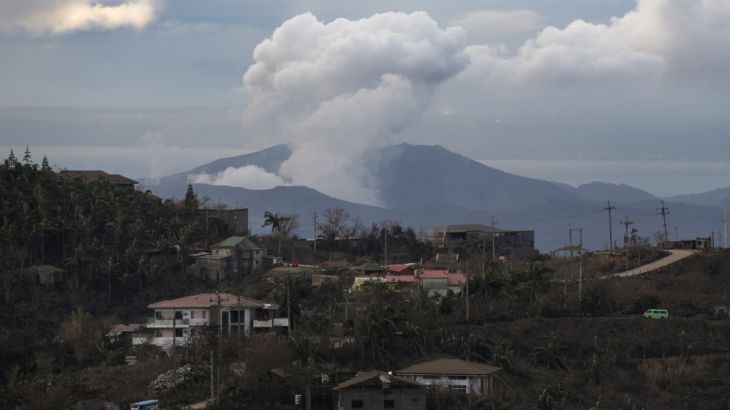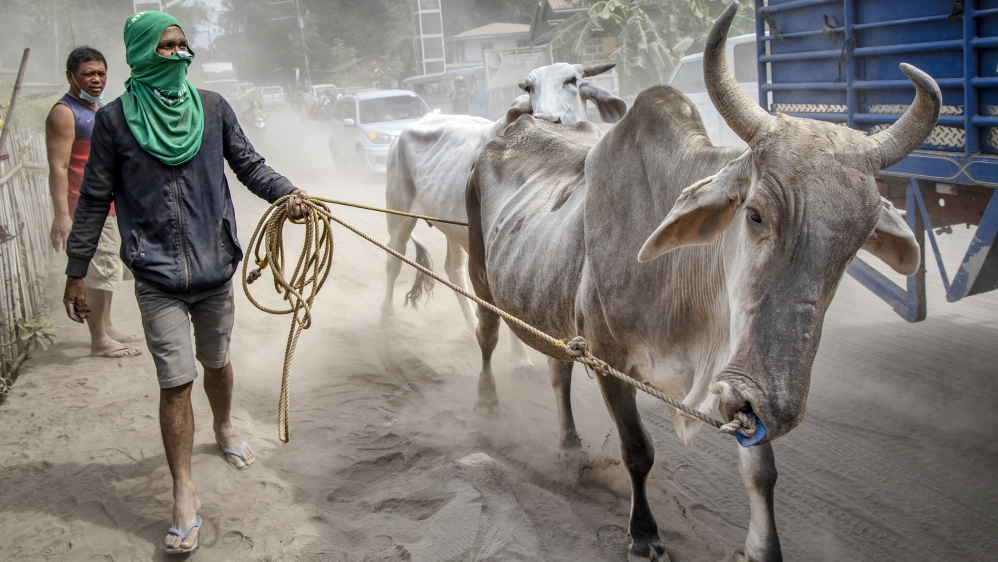Philippines’ Taal volcano still ‘life threatening’ despite lull
Officials advise thousands of displaced villagers not to return to danger zone after signs point to imminent eruption.

An erupting Taal volcano in the Philippines remains life-threatening despite weaker emissions and fewer tremors, according to an official who advised thousands of displaced villagers not to return to the danger zone.
Maria Antonia Bornas, an official with the Philippine Institute of Volcanology and Seismology, said on Friday that continuing volcanic quakes, the drying of the crater lake and other signs indicated magma was moving beneath.
Keep reading
list of 3 itemsIn Pictures: Taal volcano spews lava, sends ash clouds into sky
Philippines on alert as volcano spews ash, steam and lava
“When there is an explosion, that will be life-threatening, especially if people get very near, like on Volcano Island,” Renato Solidum, head of the institute, told The Associated Press news agency.
Al Jazeera’s Jamela Alindogan, reporting from Batangas province, said she accompanied several top government officials on their very first reconnaissance flight over Lipa City towards Taal Lake in a helicopter.
“What we saw there was beyond human comprehension. What was once a popular tourist destination is now unrecognisable. From above, we can see the animals killed when Taal Volcano spewed steam and lava. Farmlands destroyed, communities damaged. A province in crisis,” she said.

Brigadier General Kit Teofilo of the Philippine army told Al Jazeera after the flight: “It was heartbreaking to see. The devastation was terrible. As far as the military is concerned, we know that a lot needs to be done and we encourage our citizens to calm down and focus.”
Since Sunday, the volcano has remained at alert level 4, the second-highest warning, indicating a hazardous explosive eruption is possible in hours or days. Solidum said assessing whether the volcano’s restiveness has eased may take up to two weeks.
Retrieving belongings
Tens of thousands of people have been evacuated from areas now under a security lockdown, and soldiers and police have been stopping desperate villagers from returning to retrieve belongings and save their poultry and cattle.
Police have allowed batches of residents to check their homes for a few hours during the day in some high-risk villages.
Jerick Oco, a 21-year-old who worked as a tourist guide on Volcano Island which sits in the middle of Taal Lake south of Manila, was relieved to hear that the volcano was calming down but said poor villagers like him face more daunting problems, like finding new homes and jobs.
“They should help people retrieve belongings from their homes instead of blocking them. They should help them restart [their lives] again,” Oco said.
Many houses and farms are damaged by ash, though no deaths or major injuries directly caused by the eruption have been reported.
Authorities have reported one traffic fatality on an ash-covered road and an evacuee dying from a heart attack.
About 125,000 people fled their homes in hardest-hit Batangas province, more than 65km (40 miles) south of Manila.
At least 373 evacuation sites were crammed with the displaced and needed more face masks, portable toilets, bottled water and sleeping mats, according to a provincial disaster-response office.

The government’s main disaster agency reported a little more than 77,000 people were displaced in Batangas and the nearby provinces of Cavite and Laguna. The reason for the discrepancy was not immediately clear.
Among those displaced were about 5,000 people who live on Volcano Island. It is a popular tourist destination renowned for its stunning view of the volcano’s crater lake and lush hills teeming with trees and birds.
Defence Secretary Delfin Lorenzana has recommended that villagers should not be allowed back.
The 311-metre (1,020-foot) Taal is the second-most restive of about two dozen volcanoes across the Philippines.
The archipelago lies in the Pacific “Ring of Fire”, the string of faults around the ocean basin where much of the world’s seismic activity occurs.